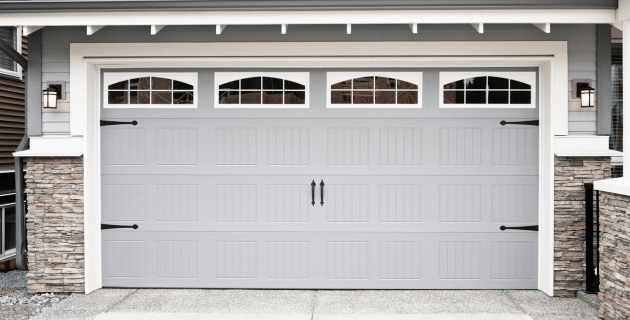
by California Casualty | Homeowners Insurance Info, Safety |
It’s relatively easy to break into a garage. Thieves can do it in a matter of seconds, and grab your tools, sports equipment, and other high-value items before you know it. Fortunately, you can take steps to protect your garage from a break-in. Follow these tips to make your garage door more secure.
Tip #1: Light the way.
Thieves lurk in the shadows. Add motion-activated flood lights around your garage. The sudden blaze of light is sure to startle a burglar and could scare him away. It also could alert neighbors or passersby to their activity, which could deter them as well.
Tip #2: Cover your windows.
You probably store high-value items in your garage, including your vehicle. Don’t broadcast that fact to everyone. Use interior curtains or blinds to cover your windows. You also can use an adhesive window film. Windows also are easy to break. Consider garage door windows with panes that are too small to use to enter.
Tip #3: Trim your landscaping.
Make sure there are no bushes near your garage where thieves can hide. You want your neighbors and every passerby to be able to see what’s going on. Pro Tip: Plant thorny shrubs under garage windows to discourage thieves from getting in that way.
Tip #4: Reinforce your service door.
If your garage has a service door that leads to the outside or inside of your home, make sure it’s secure. Most garage service doors can be broken with a well-placed, solid kick. Reinforce your door with a strike plate, using 3-inch screws to secure it.
Tip #5: Add a layer of protection with a lock.
Many garages use keyless locks which open the door with a keypad, fingerprint reader, or remote control. Alternatively, you can use a deadbolt or padlock, which require keys. You can even use a combination of locks, such as a garage door lock bar which stops the door from being raised, in combination with another type of lock for added security. Choose the one(s) that works for your budget and your needs. Pro Tip: Keep the keypad clean. A thief can look at the dirty keys to guess your garage door code.
Tip #6: Update your remotes.
If your garage door remote is old, chances are it is easy to hack. Thieves can use a code grabber that copies your signal. Then they can send it to your garage door to open it. Newer remotes use a rolling code, which slightly changes the signal that your remote sends every time. That’s a good reason to update your garage remotes to a newer model.
Tip #7: Don’t clip your garage remote to your car visor.
It’s like giving thieves a key to your home. They can just break into your car to get your remote. Consider using a smart garage door opener from your smartphone or attach your remote to your keychain so it’s always with you.
Tip #8: Close your garage door.
It may seem simple but sometimes we forget to close our garage doors. Don’t tempt thieves by leaving yours open. Consider an automatic door closer that will shut the door after a specified amount of time. You also may wish to invest in a garage door monitor, which displays whether the garage door is open or closed.
Tip #9: Protect your garage’s emergency release cord.
The emergency release cord is designed to open the garage door in a power outage. Thieves however use it to their advantage. They can push the door inward to create enough of a gap to insert a wire hook. Then they pull down on the cord. There are a few ways that you can protect the cord from this hack. You can pull the cord through a PVC pipe that is too thick and bulky to be pulled by the wire. You can cut the cord very short so thieves cannot easily grab it. You can zip tie it so it cannot be pulled. You can create a door lock shield with a scrap of plywood screwed to the opener’s arm.
Tip #10: Install a security camera.
Security cameras can help deter thieves, especially if they are visible. Make sure that the ones you buy are designed for outdoor use and specifically for the seasonal temperatures in your region. Consider features like motion-activated recording, and WiFi or mobile access via your smartphone or other device. Add a door alarm or security sensor to alert you of a breach. This is especially valuable if you are not home or are on vacation.
Finally, for added peace of mind, you will want to make sure that you fully protect your home with the right coverage. After all, your home is one of your greatest investments.
This article is furnished by California Casualty, providing auto and home insurance to educators, law enforcement officers, firefighters, and nurses. Get a quote at 1.866.704.8614 or www.calcas.com.

by California Casualty | Auto Insurance Info, Safety, Travel |
Some days it seems we’re practically living in our cars. Having the right things on hand can make our lives that much easier.
As you’re going from soccer practice to dance and back again, make sure you have the kid-friendly “must-haves” in your vehicle. In honor of Child Passenger Safety Week, we’ve also included some important items to keep everyone safe.
Essentials
Stock the basic travel items to keep everyone clean and comfortable.
- Wipes: These include wet wipes to clean hands and faces as well as disinfecting wipes for surfaces such as car seats. Up your game with stain remover wipes for those “oops” moments.
- Tissues: Travel packs are easy to store. Not only are they good for the sniffles, but they can also double as napkins after eating, or toilet paper if you’re in a bathroom that has run out.
- A towel: Dry off, clean off, or use to cover a hot seat. Towels can even double as a blanket or a napkin in a pinch.
- Scissors: These are helpful in case you need to cut a seatbelt in an emergency. In non-emergency situations, use them to cut open items that won’t easily tear.
Pro Tip: Use a laundry basket for the things going from the car into the house and back again. It’s especially useful for sports equipment.
Clothing
Keep some extra things for everyone in your family.
- Ponchos and/or umbrellas: You’ll want these for when you’re caught in the rain. You can find inexpensive disposable ponchos that do the trick.
- Extra pair of clothes: Include a change of clothes with underwear, and a plastic bag for dirty or wet things.
- Flip flops: It’s easier storing these than shoes for those times when your child splashes in muddy puddles. They’re more forgiving in size and you buy them on clearance.
- Coats, sweatshirts, and blankets: These are great when the air conditioning is blasting, or the weather turns colder unexpectedly.
Snacks and Water
Sometimes plans change, or things take longer than you expected. This way, you’ll avoid the question, “can we stop somewhere for dinner?”
- Snacks: Stock child-friendly snacks and update even nonperishable ones regularly.
- Self-serve containers: Invest in spill-proof cups and containers that enable toddlers and young children to serve themselves.
- Water: Choose reusable bottles, filled with fresh water to keep everyone hydrated. Water is also helpful when someone has sticky hands or sandy/dirty feet.
- Trash bag: You want a place where the kids can throw their trash. Disposable plastic or paper bags are good options. Make sure to empty them often.
Entertainment
Keep them occupied with their favorite activities so that you can stay focused on the road.
- Shoe box of toys: Let them decorate a shoe box and choose their favorite toys for the car. Include crayons and add some coloring books to your bag of books, below.
- Reading: Pack a bag of books for every age level. Consider audio books for longer trips.
- Power converter: Charge everything from phones to kids’ tablets to portable DVD players.
- Restaurant backpack: Stopping to eat? Fill a backpack with toys and activities for kids to use at the restaurant.
Safety
We recognize Child Passenger Safety Week each September. It’s a reminder to keep safety in mind when we’re on the road.
- LifeVac anti-choking device: Enjoying snacks in the car? This rescue suction device can save a life in a choking emergency.
- Safewise seat alarm: This device detects when you open a back door before starting the engine. It sounds a chime, then issues escalating reminders so that you won’t accidentally leave a child behind in a hot car.
- First aid kit: From band aids to antibiotic ointments, chances are you’re going to have to take care of minor injuries on the road. Make sure your first aid kit is fully stocked with the items you need. Include a first aid manual for those situations where you’re not exactly sure what to do.
- Emergency roadside kit: Make sure you’re fully prepared in case you get stuck or stranded. Flares, flashlights, and jumper cables are good things to have in your emergency car kit.
Teach your children safety in and around vehicles for added protection. Finally, protect your car with the right insurance. It will give you peace of mind as you take care of your most precious cargo—your children. Safe travels.
This article is furnished by California Casualty, providing auto and home insurance to educators, law enforcement officers, firefighters, and nurses. Get a quote at 1.866.704.8614.

by California Casualty | Educators |
It seems as if summer has flown by, and that means just one thing: school is almost here. How do you get everything done in the short time that you have left? Here’s an easy-to-follow checklist so you can divide and conquer with plenty of time to enjoy the last days of summer fun.
Classroom
Setting up the perfect environment for learning takes some thoughtful planning. Benefits of a well-arranged classroom include easier transitions and help with behavior management.
- Before you move a piece of furniture, sketch a layout that incorporates the spaces you want in your classroom.
- Plan for student seating, small group workspaces, learning centers, supply areas, class library, etc.
- Make sure your teacher’s desk is positioned so you have a good view of the whole classroom. Stock it with your favorite supplies.
- Ask a friend, family member or colleague to help you set up the room. (If you ask a fellow educator to help, make sure you reciprocate with his/her room.)
- Familiarize yourself with the classroom technology and equipment. Put in any repair requests.
- Put up classroom posters and bulletin boards. (Pro Tip: Leave bulletin boards blank with a sign saying, “under construction,” and plan to post student work there.)
- Decorate your front door to welcome students.
- Add student name plates to desks and cubbies if applicable.
- Post the emergency evacuation procedure.
- Set up fans for the first warmer weeks of school.
Organization
Set up the systems for classroom organization and you’ll appreciate the ease with which you can access items and key dates all year long.
- Find a place in your classroom for all your materials from art supplies and math manipulatives to textbooks, whiteboards, etc. Try these inexpensive organization hacks.
- Label your shelves and supply boxes to make it easier to find what you need.
- Set up student files/portfolios and your grading system. Review class lists, IEPs, allergies, and any other pertinent student information.
- Set up your planner/calendar with pertinent dates for the school year, and especially for the first marking period. Don’t forget to mark Back to School Night.
- Make student name tags for the first day, if desired.
- Have a plan for collecting and storing the school supplies that students will bring the first day.
Rules & Routines
Set the expectations right at the beginning, so that your students know the rules and routines. That will make class time more enjoyable and productive.
- Make a list of classroom rules. Include consequences if rules are broken. (You can prepare this even if you will do a similar exercise with student-led, class-created rules because you already know your behavioral management)
- Determine the rules for leaving the classroom, including bathroom breaks and visits to the water fountain.
- Finalize your procedures, including morning routine, dismissal routine, homework policy and systems for students to turn in work. You will be teaching these during the first weeks of school.
- Set your signal to get student attention. Choose the behavior management tools you will use.
- Determine student responsibilities and how you will rotate classroom duties among students throughout the year.
Lesson Planning
Keep students on track with clear daily goals for student learning. Remember that effective planning also includes some built-in flexibility to respond to student needs.
- Decide how you will structure each week based on specials, prep periods, etc.
- Prepare lessons for the first two weeks. Include icebreaker activities and lots of practice with routines.
- Plan a stress-free, no-skills-needed bellringer or morning work activity to use as needed.
- Make copies for the first week so you won’t have to worry about them. You’ll also avoid the long lines at the copier.
- Determine how, and whether, you will use music in your classroom.
- Consider classroom transformations that you may do this year as part of the curriculum.
- Write emergency sub plans. You never know when you might use them.
Family-School Connection
Building the connection with students’ families will provide a support system that enables the learning to continue at home.
- Prepare a student/family welcome letter or video. You may opt to mail the letter prior to the school year, hand it to students on the first day, or post it to your class page.
- Set up your classroom web page. Include an overview of school hours, class schedule, brief highlights of curriculum, dress code or uniforms (if applicable), and your contact information.
- List academic websites that students will use, such as leveled reading sites. Determine where you will post homework assignments and set up homework for the first week.
- Ask for class parents and parent volunteers in your welcome letter or on your class web page.
- Prepare a list of responsibilities for class parents. If you have a project in mind, like building a class library, you’ll be able to get them started.
Other
You’re not only in charge of a classroom of students, but you’re also responsible for yourself. Make sure you take the time you need so that you’re set up to do a great job.
- Get your professional clothes out of the closet. Determine if you need to update or replace any.
- Pick out your outfit for the first day of school.
- Go food shopping for healthy snacks and lunch items.
- Plan what you will pack for the lunch the first day and the first week.
- Remember to practice self-care as you return to the classroom.
We know from experience that there’s always something more to do. Don’t feel as if you must do it all. Take a breath and know that you’ve got this. Have a great year!
This article is furnished by California Casualty, providing auto and home insurance to educators, law enforcement officers, firefighters, and nurses. Get a quote at 1.866.704.8614 or www.calcas.com.

by California Casualty | Auto Insurance Info, Homeowners Insurance Info |
You slow down for the yellow light but the car behind you does not. Bam! It wasn’t your fault but now you have to get your car fixed. Or maybe a storm knocks out a window in your house. Now you need to get it repaired.
Accidents happen. Washing machines overflow; things are stolen or vandalized. That’s why you have insurance. Your policy protects your vehicle, your home, and your belongings, taking some of the financial stress away to help you repair and replace those necessary items. Here’s an overview of the insurance claims process so that you can do it easily.
When to File a Claim
Every policy has a deductible, an amount that you are required to pay out-of-pocket before insurance kicks in. The general rule is to file a claim when the payout is greater than the deductible and you cannot cover it on your own. You also should file a claim whenever someone is injured and when it’s not clear who is at fault. That way, the insurance companies can get together and determine the outcome.
How to File a Claim
Let’s say you were in a car accident. Here are the steps to take to file a claim. (You also can refer to the back of your California Casualty insurance card. It lists the steps to follow in the event of a loss.)
Step 1: Call the police if needed.
-
- Call 9-1-1 if anyone is injured or you suspect drugs or alcohol are involved.
- Call the non-emergency police number to report the accident. An officer may show up and take a police report. While you don’t necessarily need one, it will make the claims process easier. If the police are not needed, or available, you may file an accident report online, by mail, or at the police station.
Step 2: Get the other driver’s information.
-
- You feel bad so it may be tempting to say the accident was your fault. Whether or not it was, don’t take the blame. Don’t apologize.
- Exchange information. Get the other driver’s name. Take a photo of the other driver’s license, insurance card, and registration. Alternatively, you can write down the information. Make sure you have the year, make, model, license plate number, and color of the other car.
Step 3: Write down facts and take photos. Look for witnesses.
-
- Take photos of the scene, license plates, traffic signs, and anything else that may help you to remember the details of the accident.
- Include the direction the cars were traveling, your speed, weather, road conditions, and what happened.
- Use your phone to make detailed notes.
- There may be witnesses. Look around and ask for the contact information of those individuals. They may later be contacted by your insurance company or police, if needed, to support your rendition of the accident.
Step 4: Call your insurance company.
-
- Report the accident. The adjuster will ask questions. Answer them honestly and thoroughly. If you don’t know the answer, say so.
- Your adjuster will share the process of getting your car repaired. They will send you paperwork to fill out.
- Let them know if there is a police report.
- Don’t sign anything from the other person’s insurance company. Let your insurer take the lead.
Step 5: File your claim.
-
- Most insurance companies allow you to file your claim online. That means you’ll fill out the necessary paperwork online or by email.
- To complete the filing of your claim, you’ll need to fill out the forms that you are sent.
- You may have to get a repair estimate and include that information.
- Then, you’ll wait for approval. Once the repair is authorized, you’ll be able to proceed with the repairs. Either you or the repair shop will receive payment from the insurance company, so check with your adjuster.
The Difference with a Homeowner’s Claim
A homeowner’s, renter’s or personal property claim follows a similar process. The main difference is that you need to provide a Proof of Loss statement. That’s a list of items that were damaged or stolen and how much it costs to replace them.
Can you wait to file a claim?
You should not wait. Your insurance contract specifies your specific Duties After Loss. You must give prompt notice to the insurer; notify the police in case of loss by theft; protect the property from further damage, prepare an inventory of damaged personal property; and cooperate with the investigation.
So, the next time that life throws a wrench into your plans, remember that you have insurance. The claims process is an easy way to get the help you need.
This article is furnished by California Casualty, providing auto and home insurance to educators, law enforcement officers, firefighters, and nurses. Get a quote at 1.866.704.8614 or www.calcas.com.

by California Casualty | Homeowners Insurance Info |
It’s the beginning of the holiday season. In the coming weeks, you’ll be hosting guests, gathering with family, and celebrating in your home.
As a host, there’s a lot to do, so we’re here to help you get organized. From fall home safety updates to getting ready to entertain, we’ve got your November Home Checklist.
Entertaining
Entertaining is a big part of the season, no matter which holiday you celebrate. Here’s how to get your home ready.
Clean and prepare guest rooms.
Are you going to be hosting guests? Get a jump start on preparing the guest room. That way, you can give it a quick touch-up just before your guests arrive.
• Make the bed with fresh linens.
• Dust, vacuum and clear out any clutter. Empty the waste basket.
• Clear out the closet. Make sure there are empty hangers and room for a suitcase. Put an empty laundry basket in the closet for your guest’s dirty clothes.
• Set up the nightstand with a box of tissues, and don’t forget to leave the WiFi password!
Deep clean your bathrooms.
Whether or not your guests stay over, they will be using the bathroom. Do a deep clean of all of your bathrooms, but especially the ones your guests may use.
• Wash all washable items such as towels and mats.
• Scrub the shower, tub, and toilet.
• Clean the floors, walls, mirrors, and vanity. Dust the blinds.
• For overnight guests: Add a basket of travel-size toiletries your guests may have forgotten to pack.
Get your linens and serving pieces ready.
Whether you’ll be using the fine linens and China, or saving yourself some time and choosing to go with disposable utensils, make sure they are ready to go when you are.
• Launder and press fancy linens and napkins.
• Sharpen your kitchen knives. You’ll be doing a lot of cooking.
• Stock up on disposable items to get you through multiple snacks and meals.
• Pull out your favorite holiday pieces, inspect them and clean them.
Pro tip: Roll up fancy linens on old wrapping paper tubes to store them in a way that prevents wrinkles.
Decorate inside and out.
If you love to decorate for the holidays, now is the time to start. Make a realistic plan for your décor so you can ensure it’s safe and so it’s not too overwhelming.
• Many holiday traditions revolve around light. Add lights or candles, but keep fire safety in mind. Don’t overload extension cords.
• Decorate with a shopping bag nearby so you can easily toss old items you no longer use. You can donate or trash them.
• Immediately get donations out of your house by boxing them up and putting them in your car.
• Keep your holiday spending on budget whether for décor, entertaining, or gifts.
Pro Tip: To make decorating easier next year, take a picture of each room so you can easily duplicate it.
Home Maintenance
You’ll need to perform fall maintenance for your appliances and home systems. In addition, you’ll want to address common problem areas before they become problems during the holiday season.
Fix any plumbing issues.
That slow drain, finicky toilet, or nonworking garbage disposal can get worse over time. Take the time to look at these and see if you can DIY a fix or if they need professional help.
• Clean your garbage disposal to prevent it from growing bacteria.
• Use a “snake” tool to pull up debris from a slow drain.
• Fix your dripping faucets and address your running toilets, both of which can waste water on a daily basis.
• Make sure your sump pump is working before rainy season.
Cover gaps in your home.
Mice can squeeze through a gap that is about the width of a pencil. Bugs can enter even tinier cracks. To prevent rodents and bugs from taking refuge in your nice warm home, you will want to check your home for any gaps and cover them.
• You can use caulk to seal skinny gaps, squirt foam for medium-size gaps, and wire mesh and plaster for larger ones. Cover exterior vents with hardware cloth, a type of wire mesh.
• Common places for gaps are around doors and windows, where pipes and wires enter your home, or vents for exhaust fans. You also may find gaps where the wall and floor connect, and inside and around cabinets.
• Attach door sweeps to the bottoms of exterior doors.
Guard against carbon monoxide poisoning.
With the stove and fireplace in use, a buildup of carbon monoxide is common. Carbon monoxide is produced when we burn gasoline, wood, propane, charcoal, and other fuel. This gas is colorless and odorless, and can be deadly.
• Install battery-operated carbon monoxide detectors in your home (and replace the batteries each spring and fall).
• Have a professional check your heating system, water heater, and any gas or oil-burning appliances every year.
• Be careful about burning any fuels inside your home. Make sure there is proper ventilation.
• Be aware of the signs of carbon monoxide poisoning: headache, dizziness, nausea or vomiting, shortness of breath, and confusion. Get outside to fresh air, and seek medical attention.
Protect against slips and falls.
You and your guests will be walking in and around your house this season. Make sure the walkways are safe.
• Do a walk-through inside and outside your home. Make sure that there are no obstructions on common paths.
• Check that stairs and paths inside and out are well-lit. Falls can happen when you can’t easily see where you are going.
• Check railings to make sure they are secure and not wobbly.
• If you’re using a ladder for holiday decorations, make sure it is sturdy. Place it on firm, level ground. Maintain 3 points of contact whenever you climb it.
Other
Do your fall yard cleanup.
It will be winter soon. Make sure you have cleared your yard and prepared it for what’s to come so you will avoid any winter home hazards.
• Finish raking any leaves. Use a tarp to haul them to the curb or to a compost pile. Or you could run your lawn mower over them to shred them. They will decompose into a natural fertilizer.
• Remove any dead shrubs or trees. (Check for signs of life by scratching the bark at the base. If you see green, it’s alive.)
• Bring in, or cover, patio furniture.
• Only cut your grass if it is still growing. Once it’s below 50 degrees consistently, you can put your mower away.
Stock up for the winter
It’s been a while since you’ve had to use your winter gear. Make sure that it’s there and in good shape, and replace what is needed.
• Check your snow shovels, ice scrapers, and other snow tools.
• Service your snow blower and buy fuel.
• Order firewood if you use it.
• Pick up a bag of pet-safe ice melt.
• Restock emergency kits.
Check in on your home insurance policy.
For added peace of mind, check with your insurer and make sure your homeowner’s policy covers your current needs. Ask your provider about how to lower your home insurance costs.
What else is on your November Home Checklist? Tell us in the comments.
This article is furnished by California Casualty, providing auto and home insurance to educators, law enforcement officers, firefighters, and nurses. Get a quote at 1.866.704.8614 or www.calcas.com.





